J. L. C. Pompe van Meerdervoort facts for kids
Quick facts for kids
Johannes Lijdius Catharinus Pompe van Meerdervoort
|
|
|---|---|

Johannes L C Pompe van Meerdervoort
|
|
| Born | 5 May 1829 |
| Died | 7 October 1908 (aged 79) |
| Nationality | Dutch |
| Occupation | Medical doctor, educator |
| Spouse(s) |
Henriette Johanna Louise de Moulin
(m. 1864) |
| Parents |
|
Johannes Lijdius Catharinus Pompe van Meerdervoort (born May 5, 1829, in Bruges – died October 7, 1908, in Brussels) was a Dutch doctor. He played a very important role in bringing Western medicine to Japan during the Bakumatsu period. This was a time when Japan was opening up to the world after a long period of isolation.
While in Japan, Pompe van Meerdervoort taught medicine, chemistry, and photography. He also helped set up Japan's first modern medical school and hospital. Some of his well-known students included Nagayo Sensai and Matsumoto Jun.
Contents
Early Life and Medical Training
Johannes Pompe van Meerdervoort came from a noble family in the Netherlands. His father, Johan Antoine Pompe van Meerdervoort, was an officer in the Dutch army.
Johannes studied medicine at the Imperial Academy for Military Medicine in Utrecht. In 1849, he became a doctor for the navy, also known as a naval surgeon.
Bringing Western Medicine to Japan
Arrival in Japan and the Isolation Policy
In 1857, Pompe van Meerdervoort traveled to Japan. He was part of a Dutch military group. For over 200 years, Japan had a strict policy called sakoku. This meant the country was mostly closed off from the rest of the world. They only traded with the Dutch and the Chinese, and only in the city of Nagasaki.
However, by the mid-1800s, this isolation was ending. American ships, led by Matthew Perry, arrived in Japan. These "Black ships" showed Japan that it needed to learn about Western technology. So, the Japanese government asked the Dutch for help with modern science and military training.
The Nagasaki Naval Training Center opened in 1855. Dutch advisors taught the Japanese about steam warships. When Pompe van Meerdervoort arrived, he found that the previous Dutch doctor had focused more on dictionaries and engineering. This gave Pompe a chance to focus on medicine.
Founding Japan's First Western Medical School
On November 12, 1857, Pompe van Meerdervoort opened Japan's first Western-style medical school. He started with only twelve students. He taught them subjects like biology, chemistry, human anatomy, and how diseases work.
He also performed the first recorded human autopsy in Japan. This was a big step for medical learning. Soon, his student numbers grew to over 130. One of his famous students was Kusumoto Ine, the daughter of another important doctor, Philipp Franz von Siebold. The Nagasaki Naval Training Center closed in 1860, but Pompe van Meerdervoort stayed in Japan.
Opening Japan's First Modern Hospital
At that time, a serious disease called cholera was spreading in Japan. Thousands of people were dying. Pompe van Meerdervoort suggested opening a Western-style hospital. In 1861, the Tokugawa government agreed.
They opened the Nagasaki Yojosho, which had 124 beds and a medical school. This hospital is now part of Nagasaki University. People were amazed because Pompe van Meerdervoort treated all patients the same. It didn't matter if they were rich or poor.
Return to the Netherlands and Lasting Impact
In 1862, Pompe van Meerdervoort returned to the Netherlands. Two of his Japanese students went with him. They were the first Japanese people to study Western medicine abroad.
In 1867-1868, Pompe published a book called Vijf jaren in Japan (Five Years in Japan).
Pompe van Meerdervoort also taught photography. His students included Ueno Hikoma, who became one of Japan's first professional photographers. Another student, Uchida Kuichi, was the first to photograph the Emperor Meiji and Empress Shōken.
Today, a street in Voorburg, near The Hague in the Netherlands, is named Pompe van Meerdervoortstraat in his honor.

